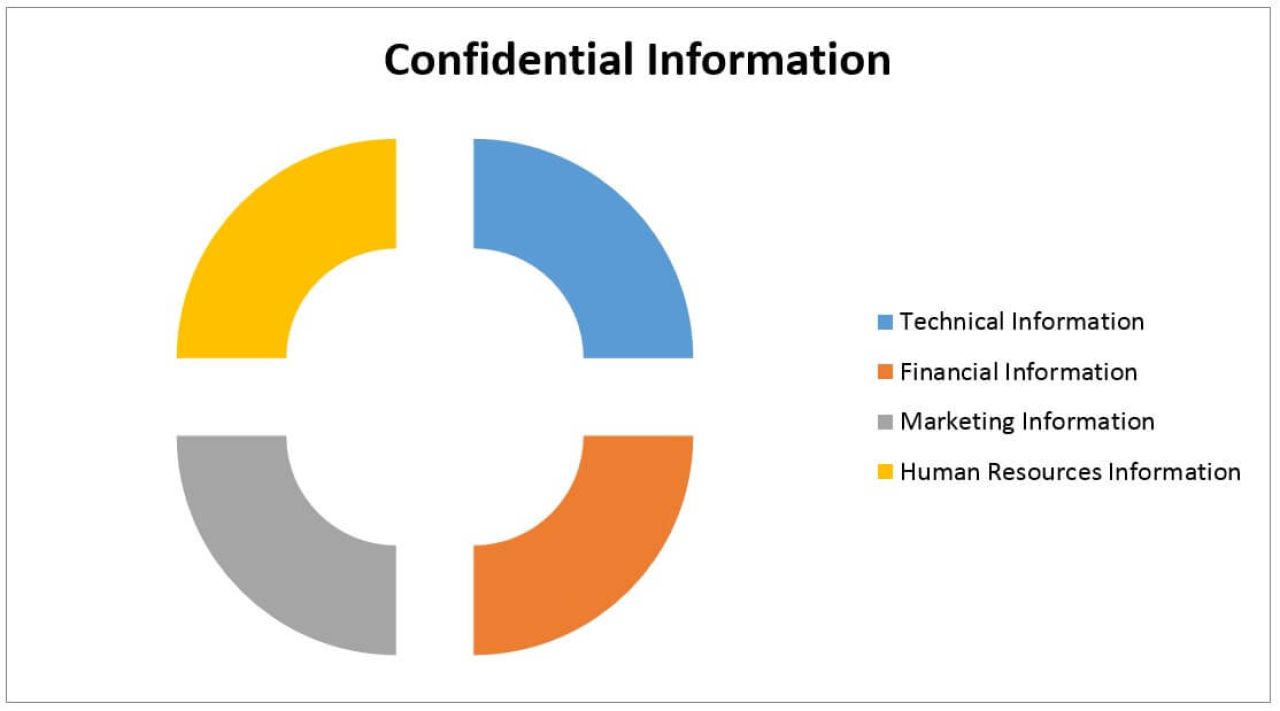How to make an NDA agreement template: NDA contract at the junction of Copyright Law

Today, many IT companies sign an NDA agreement before starting development. But, asking what it is, sometimes, not everyone could give a comprehensive response. In practice, even programmers don’t know what it means. However, in that case, they justify themselves, as though they don’t get in touch with customers closely and only do coding, not bothering about legal arrangements.
The matter of importance to know all about an NDA is a responsibility of sales managers, and business development managers as well. They conduct negotiations with customers and discuss all the aspects of future projects at the start. They define the main branch whether it is an NDA project or an ordinary one.
NDA and Copyright – Where is a connection?
The main challenge we see in an outsourcing collaboration is to define who of developers can be named as an author. Just imagine the situation: an American company hires an executor in Norway, Norway orders the same project in Georgia. Which one has copyright for the project? Whose name will be published on the ordered software? Further, we try to give comprehensive answers, but, at first, let’s plunge into some important terms to make clearer what we are talking about at all. Then, we’ll draw a line between ‘NDA’ and ‘Copyright Law’.
NDA meaning
‘NDA’ is decrypted as ‘Non-Disclosure Agreement’. It is also known as a confidential disclosure agreement (CDA), confidentiality agreement (CA), secrecy agreement (SA) or proprietary information agreement (PIA).
But, what is an NDA definition in practice? Legally, it is a contract, a deal, concluded between 2 and more parties that make a stress on aspects for divulgation and non-divulgation. These aspects can be considered individually. What is approved and what is not, the parties will write on the sheets. Thereby, an NDA forms confidential relationships between 2 parties, protecting their rights to conceal the proprietary information. In point of fact, they protect non-public business information as company’s name, project’s name, marketing features, etc.
Why do they make an NDA contract, and whether is it so necessary?
There are some reasons why the customers require an NDA contract. They all almost deal with an intention to protect a business idea. The point is that the customer is going to develop any game, website, mobile application or software, claiming a commercial profit. Moreover, an NDA agreement solves all future challenges connected with release and publishment of the project, solving many Copyright Law questions further. We’ll touch this topic in the article a little bit later.

Here are some reasons why customers usually insist on an NDA.
-
IT outsourcing
Big IT companies giving projects to another small IT companies all over the world usually strive to follow the definite template of co-working. It means that a big company won’t adapt to requirements of any small business. It just brings a contract for signing, thereby giving them a good opportunity to involve in big projects. They won’t mind of this; they will agree everything it will propose. Anyhow, the practice drives.
-
Saving the brand power
One more reason is inner company’s policy. From time to time, a company can create anything for supporting the business. It might order branding stationery on a par with branding software because the firm wishes to make an impression it is huge, powerful and able to do everything, it is a leader and on top of business stairs.
This practice is common for web development. Often, customers ordering website development wish to be an end developer of the product. Then, its name is put in the footer, and the customer concludes an agreement with a developer, containing the information for non-disclosure and mentioning the fact of transferring of exclusive rights.
-
Complex scheme of author’s right
This is the reason to make an NDA contract to prevent ‘red tape’ with author’s rights. If many sides, especially, many entities created the project, then an NDA agreement will simplify the process. Partly, this item is close to the first, because IT outsourcing usually spans too many executors working on the same product.
NDA types
Firstly, there are always 2 parties signing an agreement: Disclosing Party and Receiving Party. They influence the types of an NDA.
- The first type is a unilateral agreement. From time to time, some employers try to implement the scheme of signing an NDA form, hiring new employees. So, the document can have power between an entity and just a person, not only between entities. Usually, this practice is used in banks, data security services, governmental organizations with secret reporting, and something like that.
- The second type is a mutual agreement. The arrangments of this type resemble the first one, but there is little difference – both parties give confidential information. The mutual NDA agreement works if firms consider any joint undertaking or corporate merging.
The example! Both parties conduct negotiations for a long-term contract. The negotiations mean the exchange of information that is a commercial secret. Therefore, parties sign the Non-Disclosure Agreement.
One more example. An IT company from the USA hires a small IT company from Georgia or orders a few dedicated developers for any project. The company that dedicates working resources concludes an NDA agreement with customer’s company, and, at the same time, concludes NDA contracts with its dedicated developers, or just write this rule of law in a work contract form.
So, an NDA agreement as a legal leverage that allows one to protect commercial secrets. Its main goal is to determine responsibilities of the Receiving Party and, in the case of revealing, bring the defender to justice and recover damages. An NDA contract saves its power up to signing more one.
Explanation of some NDA terms
Firstly, let us make an introduction of some important terms, rules and exceptions. Down here, we consider the NDA template suggested by the official site ndasforfree.com.
-
Definition of Confidential Information
The term means all the information or materials having commercial value or another feature that could be useful for Disclosing Party’s business.
Written documents and other materials under an NDA should be marked with a label or a stamp with the word ‘Confidential’, or have any warming. In the case of Confidential Information is transited orally, there must be a writing explanation that the definite oral message is confidential.
What is Confidential Information?

- Technical Information. The term includes a creating formula, drafts, designs, diagrams, software code, devices, inventions, test results, product development, technical documentation and correspondence, passwords used within a project. This type of information usually appears in designing process, programming.
- Financial Information. It is costs, profits, sales information, accounting data, business plans, purchasing techniques, salaries.
- Marketing Information. Here, the Disclosing Party strives to conceal marketing ideas, advertising strategies, PR methods, customer lists.
- Human Resources Information. This item is about employees hired for an NDA project, their names, duties and personal information.
An NDA contract could also be signed in case of other non-published information that the Disclosing Party decided to conceal. Actually, parties must discuss all the items exactly – each item.
The best way to prevent deceptive situations is to be ready for them. It means, signing an NDA contract, both parties should check every word and plan the document structure thoroughly. For example, disclosing information about any software program, an NDA form should contain such statements as ‘software code’, ‘programming code’, and if this is a full circle project – such statements as ‘designing’, ‘drawing’.
-
Exceptions from Confidential Information that everyone should know
Exceptions are situations when Confidential Information is not really confidential or stops being confidential yet. For instance, it can be actual in a few cases:
-
The information has been known publicly at the moment of disclosing.
Already known information can’t be a subject of an NDA. It means that if the information has been opened once, it becomes public domain, and can’t be concealed again.
-
The information is getting known publicly, and this is not Receiving Party’s Just a blame of any third parties.
So, it means, if the information has been already discovered, the Receiving Party cannot discover it again. We cannot enter the same river twice. Likewise, the same information cannot be discovered twice.
-
The information discovered by the Receiving Party before the fact of disclosure by the Disclosing Party.
If the Disclosing Party decides to open its secrets itself, the secrets have been disclosed anymore.
-
The information getting publicly known via legal channels, not from the Disclosing Party.
For example, you conclude an NDA and, tomorrow, hear all the secrets on TV.
-
The information that the Disclosing Party agreed to reveal with writing permit in advance.
For example, the company giving work to your company requires an NDA. Sometime later, you send a request to reveal a piece of information, just a little, not in prejudice, but in favour, and a company agrees to give you a little freedom. In that case, you both sign one more additional agreement that allows mentioning a definite kind of information.
The main measures must have in an NDA agreement template
Here, you can study the main items of the future NDA contract, the most useful criteria that you have to pay attention, making up an NDA form. You can live here your e-mail to download an NDA form. But, now, let’s consider each item of the agreement.
-
Term Introduction
Here, the agreement gives us the information about the frames of the definitions. And, after, we recognize that there are some situations out of the definition, and the document prevents that such information can’t be classified as confidential.
-
Disclosure of Confidential Information
Hereto the item, we find out what is happened in case of disclosure, that divulgation may go legally. For example, if the Disclosing Party opens Confidential Information to the Receiving one piece by piece. However, it can be done only with the prior written permission of Disclosing Party’s authorized representative. Therefore, an additional document must be signed.
-
Use of Confidential Information
The item explains the main purpose of the agreement – to make convenient conditions for protecting information and preventing its leakage. The paragraph notices that all actions aim to protect Disclosing Party’s interests, and their discussions in order to improve business relationships are driven by Federal Rule of Evidence 408.
-
Receiving Party’s obligations
Speaking about obligations, parties should prevent the risks, so they have to draw their responsibilities as clearly as it is possible. Every sentence must depict every obligation.
-
Compelled Disclosure of Confidential Information
Nevertheless, there are some cases when the information may be opened. For instance, in case of governmental, administrative, judicial reasons. But, despite this, the Receiving Party must send a request to the Disclosing Party to get a written approval.
-
Timeline
The agreement lasts for 2 years, but it does not mean that after this period Confidential Information may be revealed. It is just the term marked in the document because the law requires noticing this fact. If the parties are still dealing after 2 years, the contract is prolonged by 1 more year. Nevertheless, the parties must continue to remain the Confidential Information in effect indefinitely until the Confidential Information no longer occurs as trade secrets or until the Disclosing Party gives approve for its disclosure. Thereby, just these 2 provisions could affect the termination of the NDA.
-
Remedies
Here is mentioned that Confidential Information has the most value for the Disclosing Party. And, Disclosing Party’s damages might not be calculated exactly. So, parties should agree that the Disclosing Party is empowered to forbid spreading of any Confidential Information in a court according to the NDA provisions. The Disclosing Party shall be entitled to get reliefs for any expenses as fees to attorneys, costs for a court, and recover lost profits.
-
Return of Confidential Information
If the Confidential Information was presented on devices and any carriers, the Receiving Party must give them back to the Disclosing Party after an NDA termination or by Disclosing Party’s request.
-
Notice of Breach
The Receiving Party notifies the Disclosing Party as soon as disclosure has been done, not making sense whose fault it is, and helps to prevent unauthorized use of Confidential Information and its further leakage.
When does an NDA intertwine with Copyright Law?
Concluding an NDA many companies try to be very executive and correct. They promulgate nothing about the Disclosing Party and strives to keep silence. However, the executive company that made the project would like to mention it in a portfolio. It means it needs to public project’s name, customer’s name, some pictures of the product and says that it created the product – that means it is an author. Reading the text of the NDA template thoroughly, we can see that such statements, as ‘project’s name’, ‘customer’s name’, was not mentioned. The agreement says that the objects for non-disclosing are:
- any marketing strategies, plans, financial information, or projections, operations, sales estimates, business plans and performance results relating to the past, present or future business activities of such party, its affiliates, subsidiaries and affiliated companies;
- plans for products or services, and customer or supplier lists;
- any scientific or technical information, invention, design, process, procedure, formula, improvement, technology or method;
- any concepts, reports, data, know-how, works-in-progress, designs, development tools, specifications, computer software, source code, object code, flow charts, databases, inventions, information and trade secrets.

Then, one more item goes as ‘…and any other information that should reasonably be recognized as confidential information of the Disclosing Party’. So, this point can include whatever you imagine. However, jurisprudence is too strict and exact science. It requires certainty. Therefore, this item ‘any other…’ should be explained and added to what else the Disclosing Party means here. As well, the item saying about trade secrets. Here, the parties shall clarify what secrets they are talking about.
Also, the NDA template says ‘For purposes of this Agreement, “Confidential Information” means any data or information that is proprietary to the Disclosing Party’. Pay attention to the word ‘proprietary’. What is a proprietary of the Disclosing company? We guess it might be a long list. The revision touches Copyright Law or Patent right. To claim the right to be named as an Author, the company should require singing one more agreement about transferring exclusive rights. The exclusive right is a right for the name. And, as we see, the NDA doesn’t alter this copyright revision.
Before signing any contract, parties shall be attentive and provide for all statements. And, even if the practice drives not making notices, the foregoing NDA form should be improved in avoidance of misunderstanding in the future.

 (11 votes, average: 4.36 out of 5)
(11 votes, average: 4.36 out of 5)


